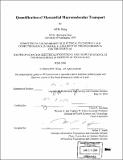| dc.contributor.advisor | Elazer R. Edelman. | en_US |
| dc.contributor.author | Hsing, Jeff M. (Jeff Mindy), 1972- | en_US |
| dc.contributor.other | Massachusetts Institute of Technology. Dept. of Electrical Engineering and Computer Science. | en_US |
| dc.date.accessioned | 2005-08-24T19:24:59Z | |
| dc.date.available | 2005-08-24T19:24:59Z | |
| dc.date.copyright | 2000 | en_US |
| dc.date.issued | 2000 | en_US |
| dc.identifier.uri | http://hdl.handle.net/1721.1/9068 | |
| dc.description | Thesis (S.M.)--Massachusetts Institute of Technology, Dept. of Electrical Engineering and Computer Science, 2000. | en_US |
| dc.description | Includes bibliographical references (leaves 66-68). | en_US |
| dc.description.abstract | The needs and impacts of drug administration have evolved from a systemic to a local focus. Local drug delivery would allow a higher local drug concentration at lower systemic toxicity than what can be achieved if delivered systemically. One of the tissues of interest for local delivery is the heart, or myocardium. Increasingly, clinicians are looking to direct myocardial delivery for therapy of complex cardiovascular diseases. Yet, there is little quantitative data on the rates of macromolecular transport inside the myocardium. A porcine model was used in this work as it is most closely similar to humans in size, structure and morphology. Using a technique previously developed in this laboratory to quantify the distribution of macromolecules, the delivery of compounds directly into the myocardium was evaluated. To make quantification generic and not specific for a particular drug or compound, fluorescent-labeled 20kDa and 150kDa dextrans were used to simulate small and large diffusing macromolecules. Diffusion in the myocardium in two directions, transmural and cross-sectional, were investigated to look at diffusion of compounds along and against the myocardium fiber orientation. Fluorescent microscopy was used to quantify concentration profiles, and then the data was fit to a simple diffusion model to calculate diffusivities. This validated the technique developed. The diffusivities of 20kDa dextran in the transmural and cross-sectional direction were calculated to be 9.49 ± 2.71 um2/s and 20.12 ± 4.10 um2/s respectively. The diffusivities for 150kDa were calculated to be 2.39 ± 1.86um 2/s and 3.23 ± 1.76um2/s respectively. The diffusivities of the two macromolecules were statistically different (p < 0.02 for transmural direction and p < 0.01 for cross-section direction). While the diffusion for the larger macromolecule was isotropic, it was not the case for the smaller one. The calculated diffusivity values in the myocardium correlated with previously published data for dextran in the arterial media, suggesting that the transport properties of the myocardium and arterial media may be similar. Applications of quantitative macromolecular transport may include developing novel therapies for cardiovascular diseases in the future. | en_US |
| dc.description.statementofresponsibility | by Jeff M. Hsing. | en_US |
| dc.format.extent | 68 leaves | en_US |
| dc.format.extent | 4839352 bytes | |
| dc.format.extent | 4839112 bytes | |
| dc.format.mimetype | application/pdf | |
| dc.format.mimetype | application/pdf | |
| dc.language.iso | eng | en_US |
| dc.publisher | Massachusetts Institute of Technology | en_US |
| dc.rights | M.I.T. theses are protected by copyright. They may be viewed from this source for any purpose, but reproduction or distribution in any format is prohibited without written permission. See provided URL for inquiries about permission. | en_US |
| dc.rights.uri | http://dspace.mit.edu/handle/1721.1/7582 | |
| dc.subject | Electrical Engineering and Computer Science. | en_US |
| dc.title | Quantification of myocardial macromolecular transport | en_US |
| dc.type | Thesis | en_US |
| dc.description.degree | S.M. | en_US |
| dc.contributor.department | Massachusetts Institute of Technology. Department of Electrical Engineering and Computer Science | |
| dc.identifier.oclc | 46805761 | en_US |
